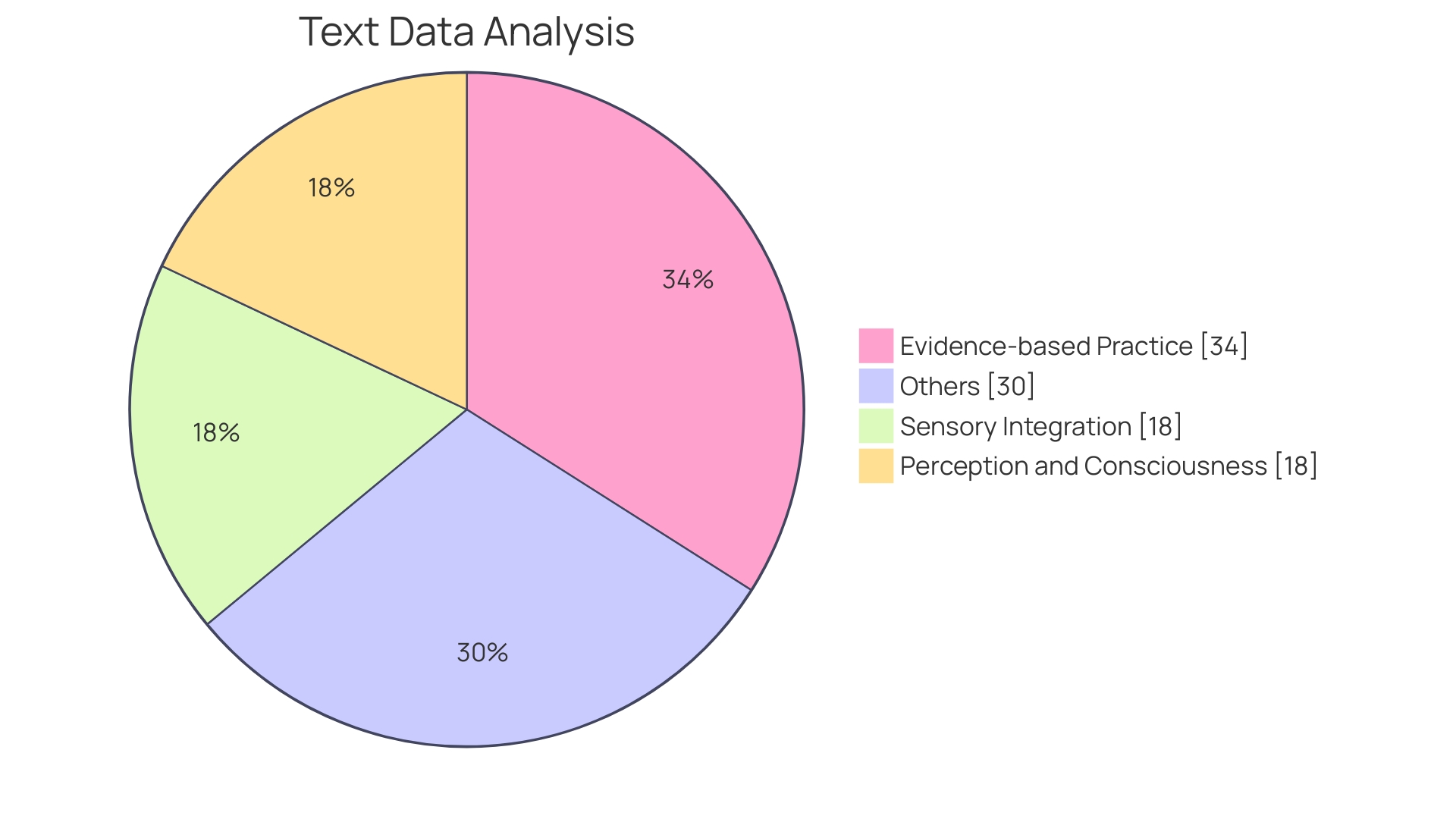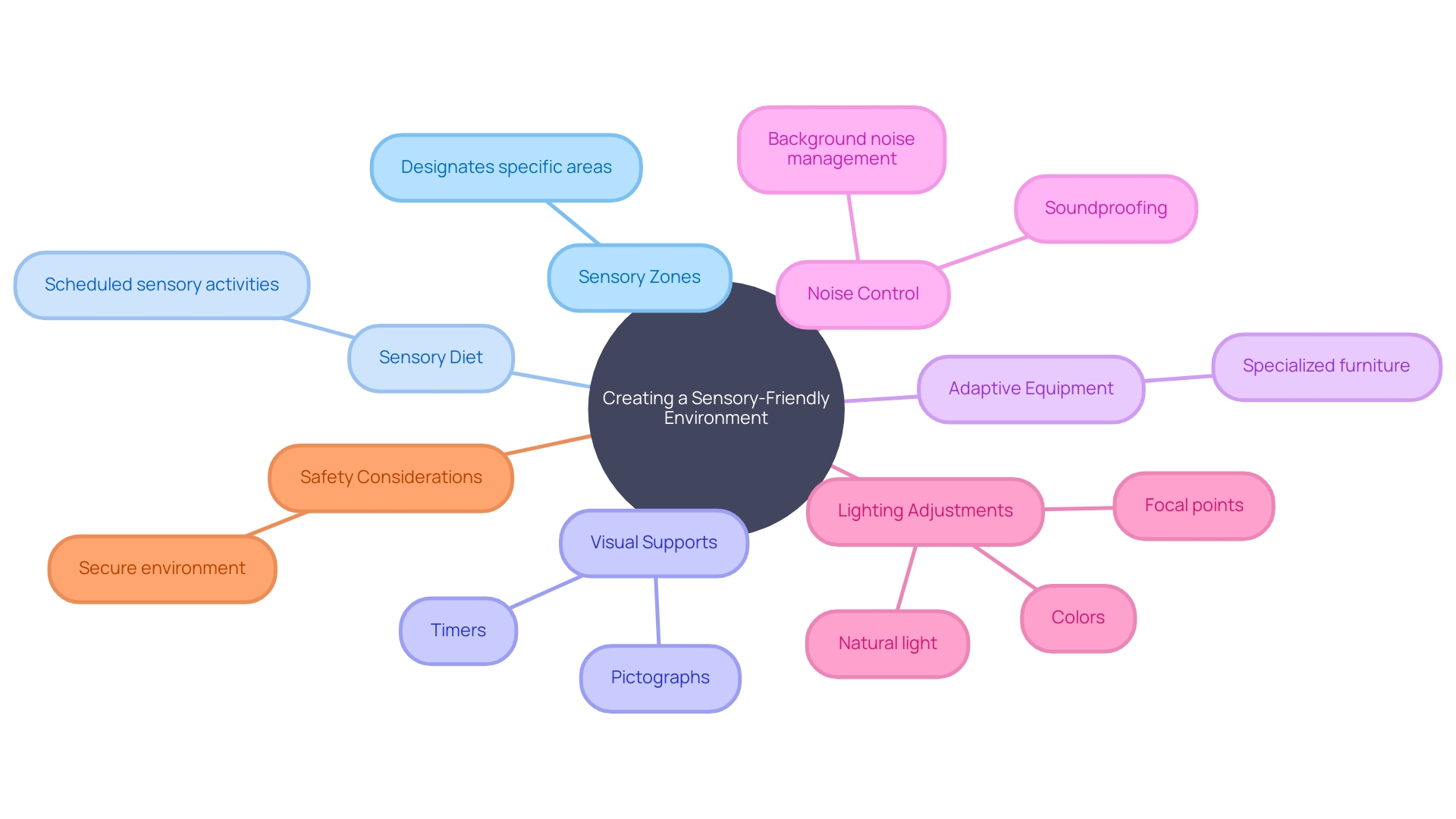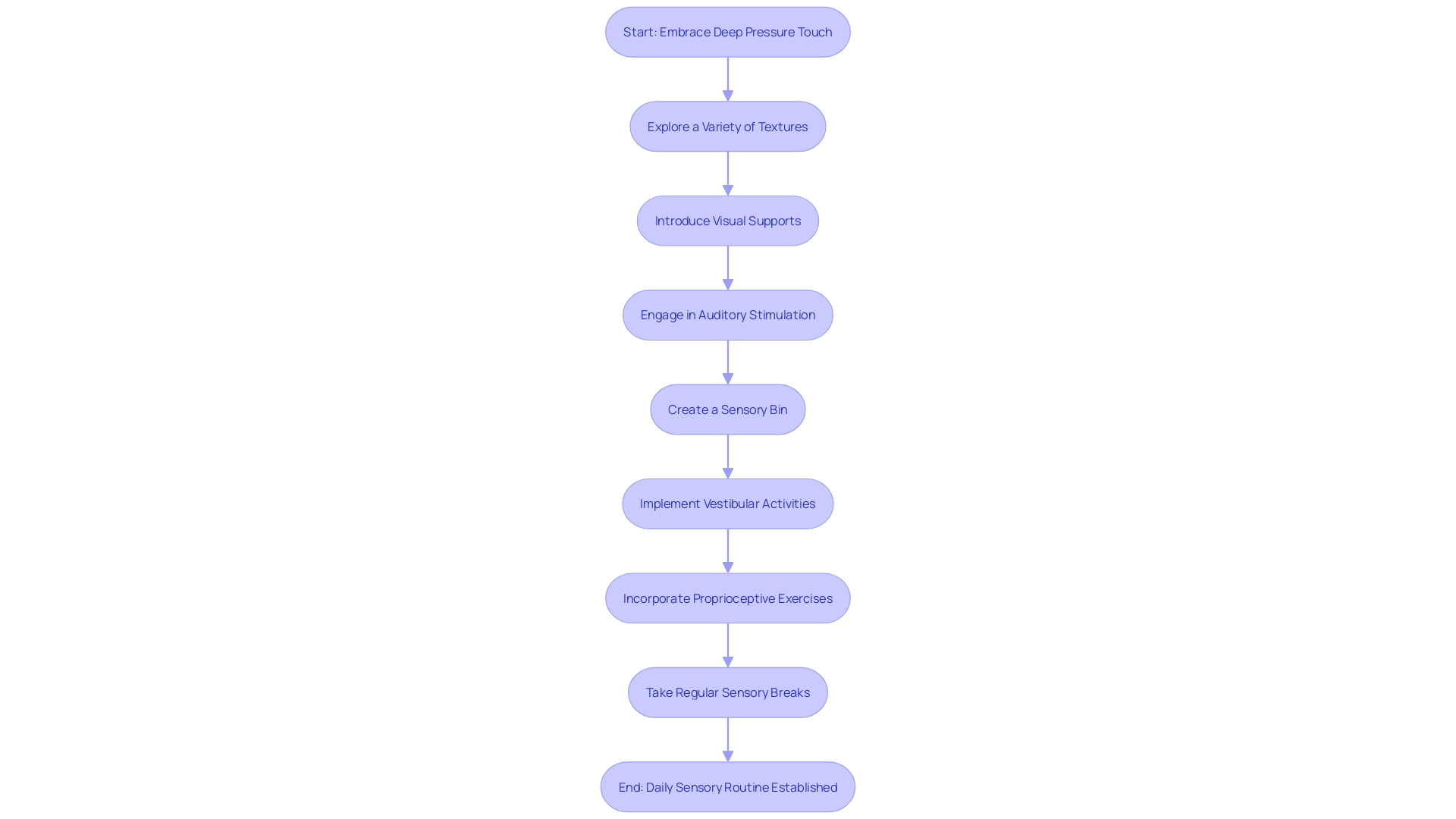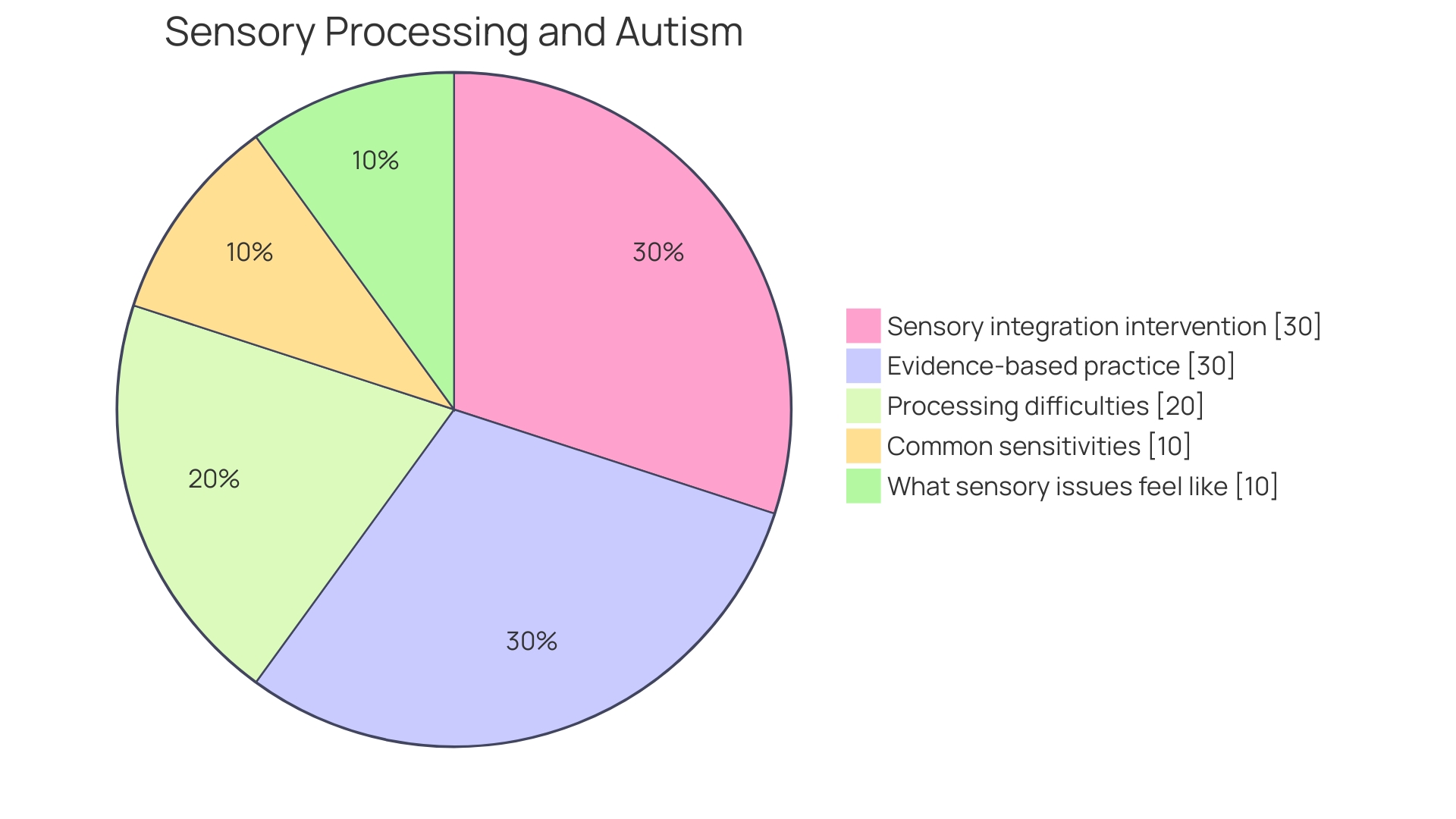Introduction
Sensory therapy is a specialized approach that addresses the intricacies of sensory processing in children. By incorporating sensory activities involving touch, smell, sight, taste, and sound, as well as vestibular and proprioceptive systems, the therapy fosters the development of language, motor skills, social interactions, and self-regulation. It's a dance of the senses that guides a child to integrate and respond to their environment in a harmonious way.
This article explores the benefits of sensory therapy, effective strategies for implementation, creating a sensory-friendly environment, and techniques for incorporating sensory integration into daily activities. It also examines case studies and success stories that highlight the profound impact of sensory therapy on a child's development. Additionally, common challenges and solutions are discussed to support parents and professionals in navigating the journey of sensory therapy.
By embracing the power of sensory experiences, parents can empower their children to thrive and navigate the world with a refined and empowered sensory experience.
What is Sensory Therapy?
Sensory therapy, a specialized approach that intersects with innovation in health technology, embodies addressing the intricacies of sensory processing in children. By incorporating sensory activities involving touch, smell, sight, taste, and sound, as well as vestibular and proprioceptive systems, the therapy fosters the development of language, motor skills, social interactions, and self-regulation. It's a dance of the senses that guides a child to integrate and respond to their environment in a harmonious way.
The dynamic nature of sensory therapy shines as we understand the layered experiences of individuals. For instance, using advanced applications like AR to translate tactile sensations into visual and auditory stimuli honors the unique sensory profiles of autistic individuals, emphasizing the need for personalized and adaptive treatment strategies. Similarly, technology initiatives like brain-computer interfaces and tongue-controlled devices embody the spirit of innovation, expanding the arsenal of tools available to enhance sensory processing and functional abilities.
With the foundation set by pioneers like Jean Ayres, sensory therapy operates on the principle of sensory integration as a key to unlocking a child's potential for learning and interaction. The therapy's efficacy is rooted in its ability to mold cognitive and motor actions, offering a gateway for praxis - the methodical conception and organization of movement. It underscores the crucial role of connecting the sensory experiences with motor planning and execution, necessary for seamlessly navigating the environment.
In summary, sensory therapy is a multilayered and adaptive approach that unlocks new possibilities for children with sensory processing challenges. It is not only therapeutic but can transform lives by enhancing one's ability to engage with the world with a refined and empowered sensory experience.
Benefits of Sensory Therapy for Children
Sensory therapy harnesses the profound effects of sensory activities, tapping into touch, smell, taste, sight, sound, as well as balance and proprioception, to significantly enhance children's sensory integration skills. Beyond just calming and syncing a child’s sensory system, this form of therapy aids in the improvement of attention and focus, enhances body awareness, and promotes emotional regulation. The gradual reduction of sensory sensitivities through therapy also leads to a decrease in stress and anxiety, which concurrently benefits social interactions and communication skills.
Highlighting the impact that sensory therapies have had on children with sensory processing issues, it's clear that they hold significant value in fostering a child's overall development, enhancing not only academic learning but everyday life experiences. Demonstrating the ability to strengthen neural pathways, sensory exercises offer tangible, even life-changing benefits. Such activities are inclusive, enriching not only for those who may be out-of-sync but also for children who are neurotypical, proving that sensory therapies stand as a pillar in supporting a wide array of developmental needs.
The advancements in health tech, including innovative interfaces that allow for sensory-sensitive control of devices, further indicate the integral role sensory integration plays in enhancing the quality of life for individuals facing various sensory challenges.

Understanding Sensory Processing Issues
Recognizing how children interpret and respond to the plethora of sensory information they encounter daily is pivotal for supporting their development and learning. Sensory processing differences are notably prevalent in autistic individuals, where even ordinary sights, sounds, and smells can trigger heightened responses leading to overstimulation, or be barely noticed at all, leading to insufficient stimulation. These sensory processing challenges can significantly affect behavior, academic progress, and social interactions—demanding vigilant attention for tailored support.
Occupational therapists pioneered the way with interventions like Ayres Sensory Integration™, devised more than five decades ago. Today, this approach, alongside modern evidence-based practices, offers frameworks that guide therapeutic interventions for sensory-motor challenges, signaling the profound effect of sensory integration on children's occupational performance and overall mental health. Valid assessments and targeted strategies developed through rigorous research and clinical expertise enable a closer look at individual patterns of sensory processing and its long-term impacts on health and well-being.
Highlighting the role of sensory-rich play in promoting creative thinking and self-expression, companies like Solobo have taken inspiration from Montessori teachings to design toys that go beyond convention. These playthings invite imaginative exploration and cultivate essential skills, aligning playtime with sensory development. Occupational Therapist Christina Kozlowski, through the Sensory TheraPLAY Box initiative, emphasizes how sensory toys can advance sensory integration and processing capacities, fortifying hand-eye coordination, spatial awareness, and promoting the invaluable skill of self-regulation.
Amid these strategies and tools, it is equally important to consider lifestyle factors such as screen time. Emerging research points to the significance of adhering to pediatric screen time recommendations to prevent potential risks of atypical sensory processing.
As we navigate these multi-faceted sensory challenges, understanding the sensory world from the perspective of autistic individuals remains a vital underpinning. This not only aids in crafting supportive environments at home, school, or workplaces but also in fostering their potential to thrive in a world that's rich with sensory experiences.
Effective Strategies for Sensory Therapy
Sensory therapy for children with sensory processing challenges requires a nuanced and responsive approach. For children who are over or under-sensitive to environmental stimuli, the following strategies are critical for positive therapy outcomes:
- Customized Therapeutic Programs: Each child's sensory profile is unique, with specific preferences, sensitivities, and triggers. By understanding these individual characteristics, therapy can be customized, creating interventions that directly address each child's sensory experiences.
- Staged Sensory Integration: Introduce new sensory experiences with care, starting with less intense stimuli and progressively intensifying them. This method respects the child's current sensory thresholds while encouraging gradual adaptation and the development of coping mechanisms.
- Consistent Routines: Frameworks providing consistent, predictable sensory activities help establish a safe environment for children. Regular engagements where they know what to expect can significantly reduce anxiety and enhance comfort during therapy.
- Family Engagement: When parents are integrally involved in the therapeutic process, they gain the knowledge and resources to support their child's sensory experiences beyond the therapy environment. This reinforcement at home is crucial, enabling parents to foster their child's sensory growth across various settings.
- Integrated Sensory Activities: Engaging multiple senses simultaneously can lead to a more robust experience for children. This multi-sensory approach can encourage more profound sensory integration, tapping into the child's various sensory systems to create a comprehensive engagement.
- Play-Based Learning: Utilizing play as a central element of sensory therapy encourages exploration and interaction with sensory inputs in a naturally engaging way. Playful activities are more likely to elicit enthusiastic participation and sustain the motivation of children throughout the therapeutic process.
- Continuous Monitoring and Adaptation: Keeping a close eye on a child's developmental progress within sensory therapy is vital. Regular evaluations allow therapists to tailor strategies as needed and target areas that require additional attention.
Implementing these personalized, gradual, and engaging sensory therapy strategies not only aligns with the experiences of individuals with unique sensory needs, such as those facing the challenges of autism, but it also ensures that sensory therapy remains relevant and effective in fostering developmental growth. These methods are backed by the multitude of benefits that sensory activities bring to children across the spectrum of sensory experiences. They help synthesize the sensory system, enhance cognition and communication, and have been found to be integral in supporting behavioral regulation and overall development.
Creating a Sensory-Friendly Environment
A sensory-friendly environment not only offers comfort but also plays a crucial role in enhancing sensory therapy. To tailor such an environment effectively, consider the following:
- Sensory Zones: Craft areas within the environment dedicated to distinct sensory experiences. For example, a cozy corner can be a retreat for decompression and calm, whereas a separate space can be bustling with activities that stimulate gross motor skills. Each zone, by catering to individual sensory needs, acts as a sanctuary for personalized therapeutic engagement.
- Sensory Diet: A well-structured routine involving sensory activities distributed throughout the day, known as a sensory diet, is pivotal. Activities may range from swinging to soothing deep pressure touch or the embrace of calming melodies. Sensory diets are instrumental in moderating sensory stimulation and bolstering self-regulation.
- Visual Supports: Structured visual aids – like schedules, timers, and cues – provide a framework for understanding daily routines. Such support helps children in anticipating events, thereby mitigating anxiety and nurturing independence.
- Adaptive Equipment: By integrating tools such as weighted blankets, fidget gadgets, or sensory pillows, children can better manage their sensory input. These aids contribute to a child’s comfort and facilitate active engagement with their surroundings.
- Noise Control: Establishing an oasis of tranquility for sensory activities can be as simple as minimizing auditory disturbances. Sound-absorbing materials, noise-canceling headphones, or even the gentle lull of white noise machines can create the serene atmosphere required for concentration and relaxation.
- Lighting Adjustments: The level and quality of light have direct implications on sensory experiences. Possessing the flexibility to modulate lighting – with dimmers or by utilizing daylight – can profoundly enhance a sensory space.
- Safety Considerations: Above all, safety is paramount. Cushioning for floors, securely anchored equipment, and transparent safety directives are essential to ensure a secure environment where children can explore and grow without the risk of injury.
These strategies, employed with understanding and creativity, transform any space into a nurturing haven that responds to An individual's sensory needs with empathy and care.

Sensory Integration Techniques for Daily Activities
Understanding and aiding sensory integration in children is pivotal, as it underpins their capacity to process and respond to the world around them. For parents looking to infuse sensory integration methods into their child's day, consider these purposeful activities:
- Embrace the soothing powers of Deep Pressure Touch, like warm bear hugs or the gentle pressure of weighted blankets, to mollify the nervous system, offering a serene haven for children who may feel overwhelmed.
- The renown Wilbarger Protocol, with its systematic deep pressure brushing, targets tactile sensitivities, facilitating the integration of sensory experiences.
- Encourage Heavy Work Activities, such as moving or carrying weighty items, to bolster proprioceptive input, which not only aids in body awareness but also enhances motor coordination.
- Delve into Oral Sensory Activities, from the simplicity of bubbles to the rhythmic motions of chewing gum, which nurture oral sensory regulation and pave the way for self-regulation.
- Introduce your child to Vestibular Stimulation with fun exercises like swinging, which fosters essential skills such as balance and spatial orientation.
- Implement Visual Supports to create structured visual pathways that can simplify daily transitions, offering clarity and predictability.
- Regular Sensory Breaks can serve as a haven for children, providing a chance for self-regulation with activities that invigorate the senses, from trampoline bounces to the tranquility of deep breathing exercises.
Integrating sensory experiences is more than just beneficial—it can reshape neural pathways, reinforcing cognitive and motor connections. By applying these techniques, experiences can transform into moments of tranquility and harmony in a child's sensory journey.

Case Studies and Success Stories
Successful interventions in sensory therapy open a world of possibilities for improving a child's sensory processing abilities and their overall quality of life. For instance, take an innovative AR application that translates tactile sensations into visual and auditory cues specifically designed with autistic patients' needs in mind. This approach showcases a pivotal shift in therapeutic practices tailored to individual sensory tolerances, such as the distress from a dental chair's texture or the startling vibrations of dental equipment.
Similarly, another notable case is of young Adleigh Barlow, who perceived the world differently due to her unique visual sensitivities. Her experience underscores the importance of recognizing and catering to the individual sensory needs of each child.
The profound effects of sensory integration interventions on a child's development are well-documented, reflecting improvements in academic performance, behavior, and mental health. With over 50 years of evidence, Ayres Sensory Integration™ has emerged as a gold standard, directly impacting occupational outcomes and fulfilling the desires and experiences of the clients.
As the world of health tech evolves, so do the resources available for those with sensory needs. Companies like AAVAA and Augmented are pioneering interfaces that enable interaction with devices via eye movements and the tongue, respectively, signaling a future where every sensory requirement can be met with innovation.
The intersection of personalized care plans, like those offered by Proxie, with the latest technological advancements in health monitoring, such as Senbiosys's smart ring, illustrates a comprehensive approach to care that prioritizes understanding each individual's sensory world and the successful strategies to navigate it.
In summary, continued innovation in sensory therapy, guided by evidence-based practice, is the keystone for empowering and enhancing the well-being of children with sensory processing challenges, offering reassurance and effective solutions for their families and therapists.
Common Challenges and Solutions
Parents and professionals may face several challenges when engaging in sensory therapy. Recognizing these challenges and devising strategies to deal with them is crucial for success. For example, children may sometimes show reluctance to engage in sensory activities.
To help them adapt, one can introduce these activities progressively, offer choices to the child, and include their favorite sensory activities to make the process more appealing.
When there is limited access to specialized sensory tools or professional services, parents can look into alternative resources that might be available in the home or community settings. Additionally, ensuring that the sensory skills learned in therapy are applied in everyday life can be difficult. Incorporating these skills into natural contexts and helping parents continue these practices at home can significantly assist in this transition.
Children's unique sensory profiles can also pose a challenge since each child responds differently to sensory inputs. Ongoing evaluation and tailoring interventions to fit each child's specific needs and preferences are key to effectively supporting them. Furthermore, a lack of parent education on sensory processing complexities can limit parental involvement.
Therefore, it's essential to offer education, resources, and support groups to empower parents in aiding their children with sensory needs.
- "Sensory activities engage the 5 senses – touch, smell, sight, taste, and sound – as well as the vestibular and proprioceptive systems. When my child engages in sensory play, it calms them significantly, and they retain information longer when learning through sensory activities as opposed to traditional methods," said one parent, underlying the multifaceted benefits of sensory exercises, which include enhancement of language, social, and motor skills, while providing calmness and better self-regulation.
Recent technology advances highlighted by AT-Newswire showcase innovative tools that can be adapted for sensory activities. Companies like AAVAA and Augmented are creating interfaces that help overcome sensory challenges via eye movement and tongue control, respectively. While Proxy has developed a community-oriented platform for caregivers to share their experiences and access personalized care plans, Senbiosys is advancing health monitoring through their sensory-based products.
These insights remind us that sensory integration therapy, conceived by Jean Ayres in the 1970s, revolutionized the way we view sensory processes today. Ayres emphasized the brain's pivotal role in interpreting, integrating, and responding to sensory stimuli, and the importance of praxis—or will-based activity—to enact cognitive concepts through motor actions.
By fostering an understanding of the complex world of sensory processing and integrating holistic approaches into their practice, parents can give their children a significant advantage in mastering self-regulation skills and developing healthy relationships, thus paving the way for a more empowered transition into adulthood.

Conclusion
In conclusion, sensory therapy is a powerful approach that fosters the development of children by incorporating sensory activities. It improves language, motor skills, social interactions, and self-regulation. The therapy's effectiveness lies in its ability to mold cognitive and motor actions by connecting sensory experiences to motor planning and execution.
Sensory therapy offers numerous benefits, including improved attention, body awareness, emotional regulation, and social communication skills. It reduces stress and anxiety, strengthens neural pathways, and enriches a child's everyday experiences.
Implementing effective strategies is crucial for successful sensory therapy. Customized programs, staged sensory integration, consistent routines, family engagement, integrated activities, play-based learning, and continuous monitoring ensure personalized and engaging therapy.
Creating a sensory-friendly environment enhances sensory therapy. Sensory zones, a sensory diet, visual supports, adaptive equipment, noise and lighting control, and safety considerations provide a nurturing haven.
Integrating sensory techniques into daily activities supports a child's sensory processing. Deep pressure touch, Wilbarger Protocol, heavy work activities, oral sensory activities, vestibular stimulation, visual supports, and sensory breaks promote self-regulation and cognitive development.
Case studies and success stories highlight the transformative impact of sensory therapy. Innovations in health tech and personalized care plans enhance care and monitoring.
Despite challenges, such as reluctance to engage and limited access to tools, there are solutions available. Progressive introduction, alternative resources, incorporation into natural contexts, tailored interventions, and parent education overcome challenges.
By embracing sensory experiences and following effective strategies, parents empower their children to thrive and navigate the world with an empowered sensory experience. Sensory therapy fosters self-regulation and healthy transitions into adulthood.




